If I asked you to hum the melody that first comes to mind when you think of door chimes or a grandfather clock, most of us would hum the same tune: the Westminster chime – or, more accurately, Westminster Quarters. Or even more accurately, Cambridge Quarters.
Originally written for a clock and bell tower at the Church of St. Mary the Great – the university church of Cambridge – the Westminster chime has become the de facto melody of chimes around the world.
Created in 1793, the Westminster chime rang in Cambridge for 66 years before it was adopted for the new clock tower at the Palace of Westminster in London in 1859. Thanks to the fame of the impressive tower, its massive Great Bell (better known as Big Ben), its clock, and the distinctive quarters chime of the four quarter bells, the melody quickly became associated with the Westminster tower and known by that name.
So though today we know it as the Westminster chime, the Cambridge Quarters birthed a melody that would go on to chime in all corners of the world.
The melody has become ubiquitous from east to west; for example, many schools in Japan, Taiwan, South Korea, and China use the tune to signal the beginning and ends of school periods.
Various musical pieces have incorporated it as well, from symphonies to a modern song by rock band U2. A Nintendo video game used the chimes to indicate the coming sunset in the game, while real life sports teams (such as the New York Yankees and Los Angeles Lakers) have also used the melody.
Perhaps the most impressive integration into popular culture, however, is the “Pompey Chimes,” a raucous chant by supporters of Portsmouth F.C. inspired by the Portsmouth Guildhall clock tower, which – you guessed it – uses the Cambridge Quarters melody.
Alas, while many people know the melody, they undoubtedly call it the Westminster chime. And when it comes to common usage in language, vox populi rules.
So it should come as no surprise that watch brands developing a grand sonnerie or musical watch usually use the Westminster chime. After 160 years, it’s pretty much tradition.
Speaking of that tradition, at SIHH 2019 Jaeger-LeCoultre launched an incredibly complicated watch featuring the Westminster chime: the aptly named Master Grande Tradition Gyrotourbillon Westminster Perpétuel. That a mouthful of a name, but happily it’s also known as the Gyrotourbillon 5.
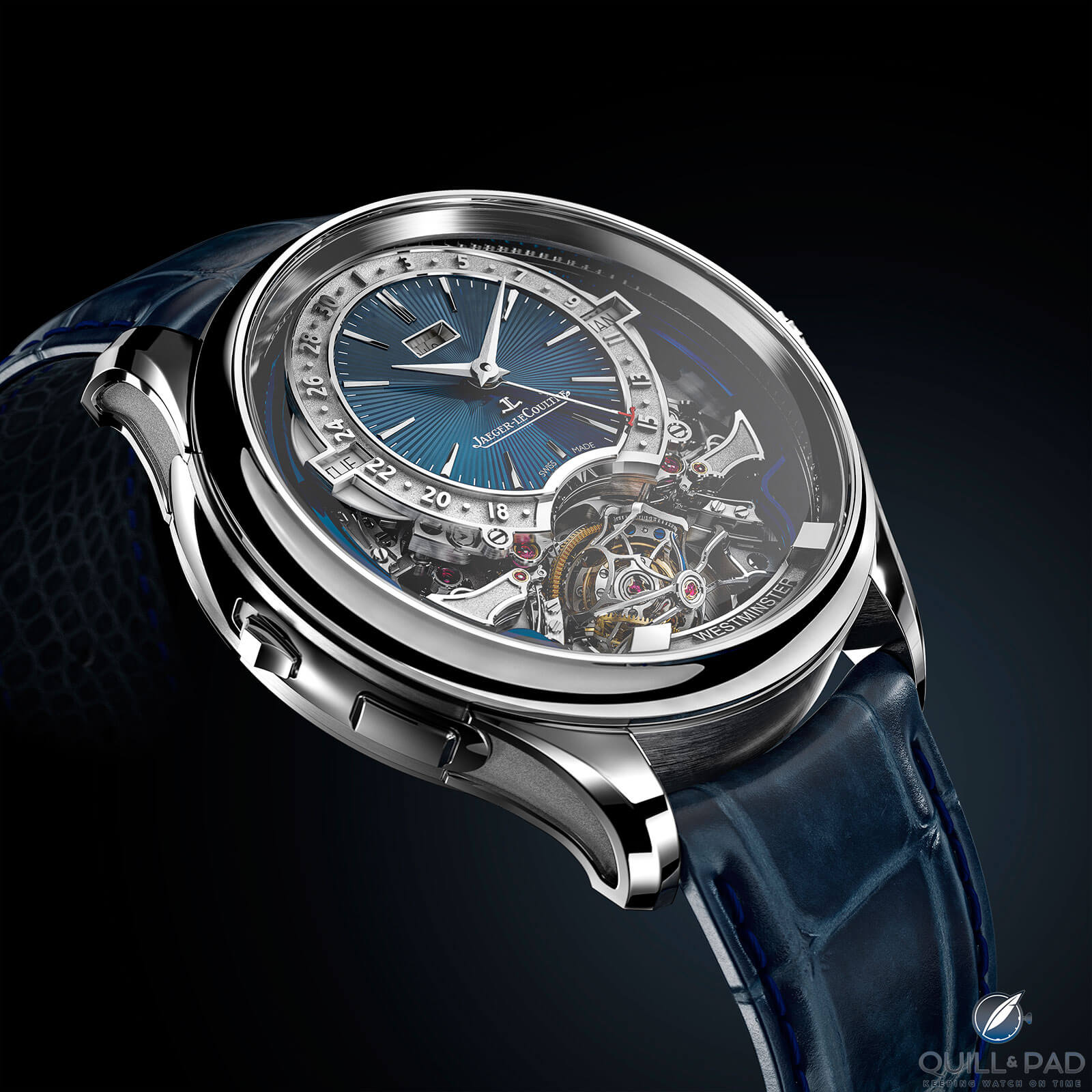
Jaeger-LeCoultre Master Grande Tradition Gyrotourbillon Westminster Perpétuel
And I’d like to share just what makes it special.
Jaeger-LeCoultre Gyrotourbillon 5: the basics of an anything-but-basic watch
In short, the Master Grande Tradition Gyrotourbillon Westminster Perpétuel is a smaller version of the biaxial Gyrotourbillon that has been updated with a perpetual calendar, minute repeater with Westminster chime, one-minute remontoir d’égalité, a jumping minute hand, and a jumping date display.
All of that together already makes the Gyrotourbillon 5 a stunner, but aside from the main talking points it is all the little details that take this watch to an entirely different level.
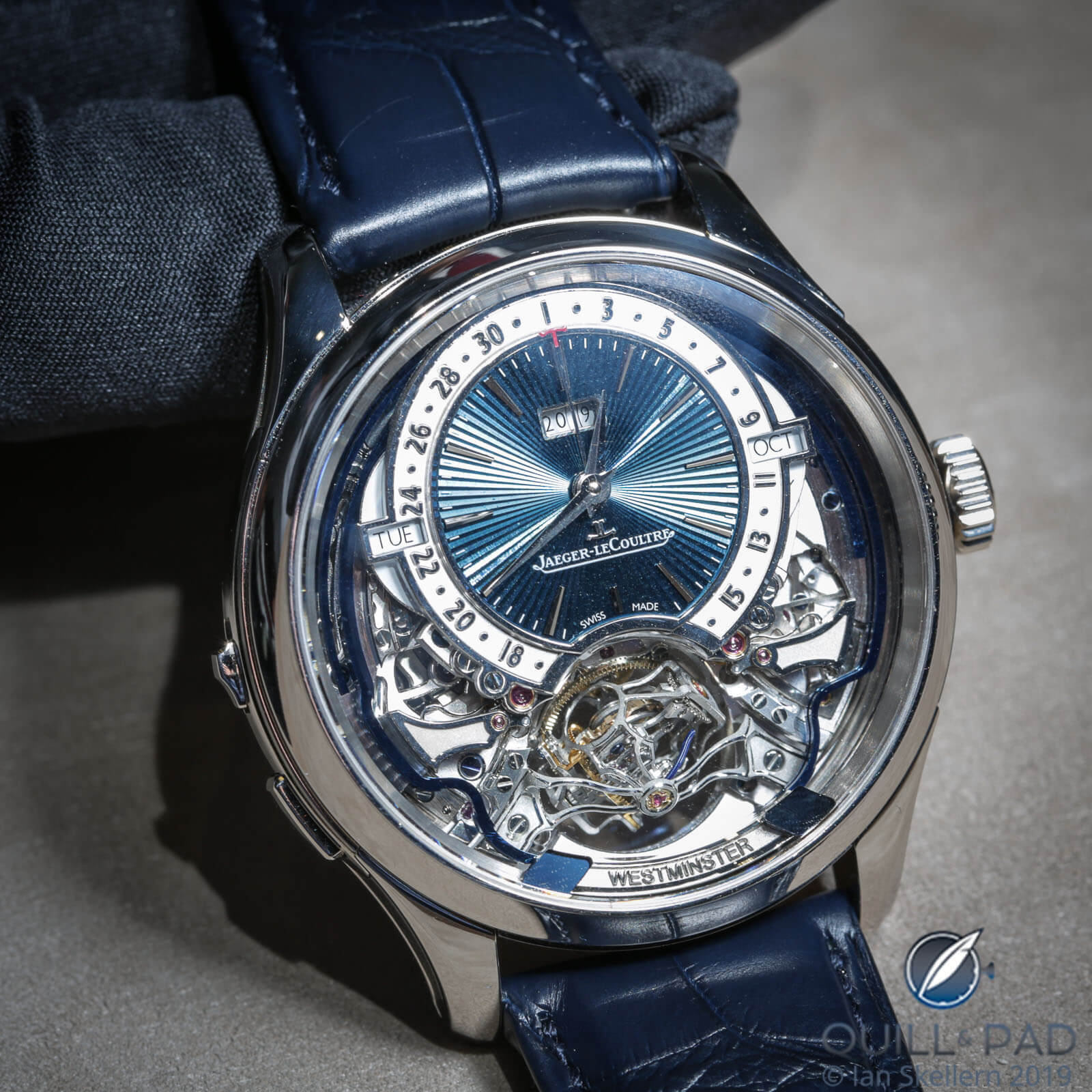
Jaeger-LeCoultre Master Grande Tradition Gyrotourbillon Westminster Perpétuel
Gyrotourbillon 5 is the third model of the Gyro series in the Master style, and by far the most complicated of the bunch. With an equation of time and perpetual calendar, the original Gyrotourbillon 1 of 2004 has led the group in complexity until now; however this latest model surpasses the first with the addition of a minute repeater with Westminster chime and a remontoir d’égalité to provide constant force to the Gyrotourbillon’s regulator.
Like its predecessors, Gyrotourbillon 5 is almost entirely skeletonized to display its impressive mechanics, with a gorgeous offset dial in high-fire enamel and guilloche or a more restrained grained silver, both surrounded by a deeply engraved chapter ring displaying the date.
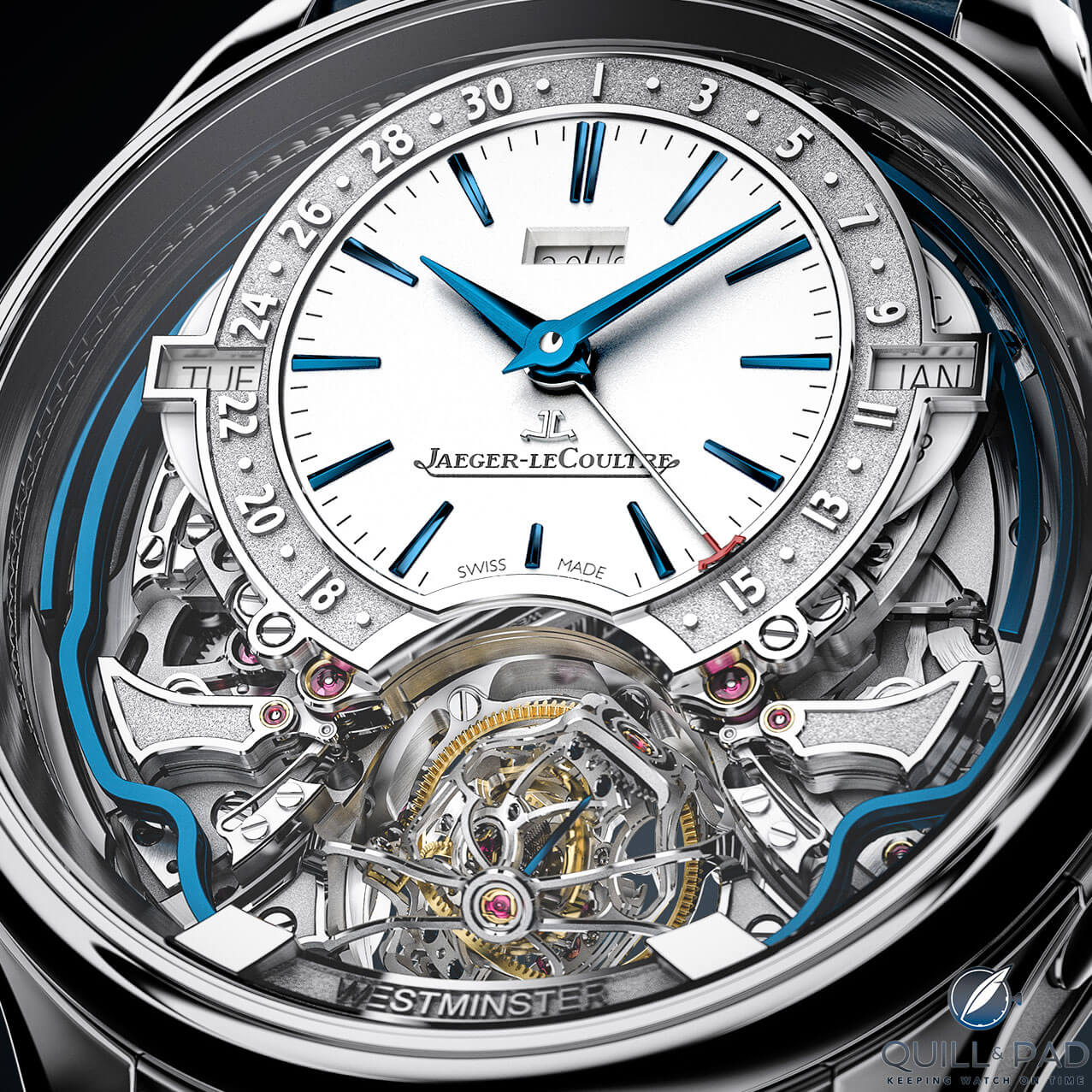
Jaeger-LeCoultre Master Grande Tradition Gyrotourbillon Westminster Perpétuel
The four kinked gongs are deep blue, mirroring the blue hues found throughout the movement and complementing the numerous jewels supporting various axes on the front and rear. The finishing across the bridges, plates, levers, springs, wheels, and hammers is terrific, with my personal favorite detail being the recessed and grained repeater hammers flanking the Gyrotourbillon.
The style is somewhat subdued when considered against some of the more outrageous grand complications, but very tastefully mechanical in its aesthetic. That aesthetic serves the Gyrotourbillon 5 well since it highlights the features of the complicated movement.
Jaeger-LeCoultre Gyrotourbillon 5 in detail
Let’s begin with the Gyrotourbillon itself. Jaeger-LeCoultre released its first biaxial tourbillon in 2004. This was followed by Gyrotourbillon 2 in a Reverso case and then reimagined for the Gyrotourbillon 3, which after losing a large supporting bridge (and gaining a spherical hairspring) became the first flying Gyrotourbillon. The Gyrotourbillon 4 diverted strongly from all its predecessors, looking more like a rolling bridge in a plane parallel to the movement.
In essence, the Gyrotourbillon 5 has gone back to the original design, but boasts a completely re-engineered the mechanism and significant reduction in size. Despite its additional minute repeater, the case thickness of the Gyrotourbillon 5 is a nearly one millimeter thinner than the original Gyrotourbillon 1, which “only” featured a perpetual calendar and equation of time.
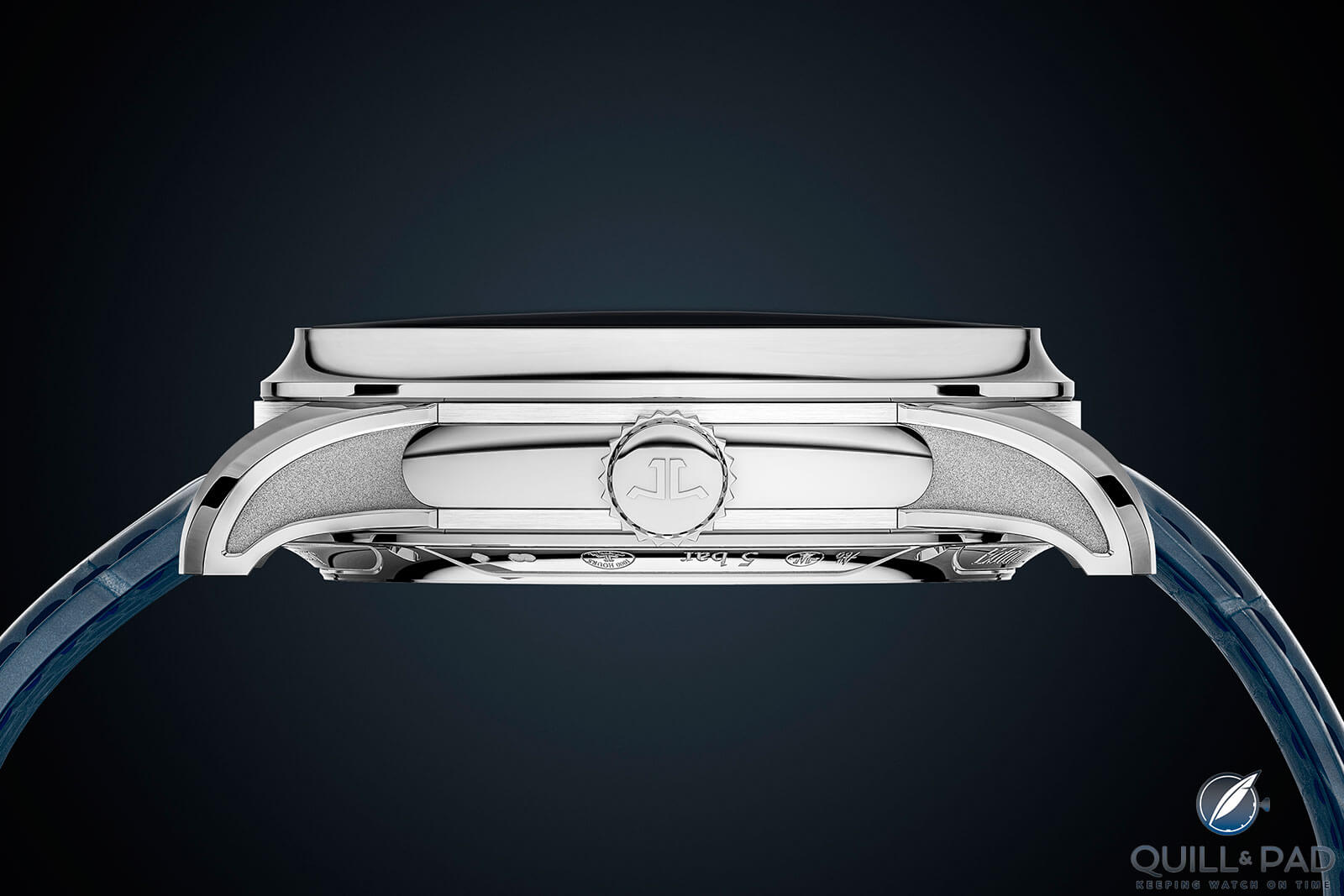
Jaeger-LeCoultre Master Grande Tradition Gyrotourbillon Westminster Perpétuel in profile
The reduction in size also makes the Gyrotourbillon more stable thanks to lower inertia providing higher shock resistance. The 94 components making up the Gyrotourbillon weigh just 0.4 grams, making this one light assembly.

A multi-axis tourbillon regulator beats at the heart of the Jaeger-LeCoultre Master Grande Tradition Gyrotourbillon Westminster Perpétuel
The reduction in size also allows for the addition of the cool minute repeater function with Westminster chime, a complication taking up a fair amount of room due to the four hammers and gongs.
The hammers, stacked two by two and looking like a pair of wings for the tourbillon, aren’t just regular hammers, though: they are the brand’s own trébuchet hammers, meaning that the hammer is able to pivot separately from the lever activating it. A fine spring allows the hammer to fall more solidly onto the gong without being limited by the counting ratchet. The difference is small but leads to an improved sound of the chime.
The gongs aren’t simple, either. They are kinked, which seems primarily a design function allowing the hammers to be horizontal instead of at an angle, which means the gong comes out to meet the hammer at its natural strike point.
The gongs have a square profile as they were cut from a flat material to create the unique shape, making the gongs on the left side literally dodge out of the way of the two hammers. The square section also provides a larger strike area, creating a more consistent strike.
The gongs are crafted in a beautiful blued steel and, most importantly, connected to the front crystal via two posts extending off the mounting block. This allows for a cleaner transfer of the sound, increasing volume.
Little details are big deals
Those details alone are rather awesome, but this piece isn’t done yet. Not by a long shot.
Despite its lightness, a Gyrotourbillon is power hungry and susceptible to power delivery fluctuations. That is why the Gyrotourbillon 5 features a one-minute remontoir d’égalité, ensuring a much more consistent power delivery to the mechanism and minimizing errors from the varying torque of the mainspring.

Jaeger-LeCoultre Master Grande Tradition Gyrotourbillon Westminster Perpétuel
The remontoir d’égalité has another big benefit: it creates a one-minute jump for the minute hand.
That jumping minute hand, while being a sweet feature, has a very practical function to the minute repeater: consistent time striking. Should the minute hand be between minutes when the minute repeater is activated, the mechanism can record the time incorrectly and ring the time a minute fast depending on how the mechanism is tuned.
The jumping hand ensures that the Gyrotourbillon 5 will always chime the minute it shows.
The chiming of the Gyrotourbillon 5 is also controlled differently from most repeaters: for one, it has a time-lapse reduction mechanism to reduce pauses between different chimes, providing a smooth cadence no matter the chime time.
But that is almost secondary compared to how you activate the mechanism in the first place. The minute repeater activator is not a usual slide or a simple push button, but instead a flush-mounted button released by a switch at 9 o’clock, allowing it to pop out from the case. When no longer in use, the button is pushed back in to charge the repeater and activate it, at which time the button is also locked into place nearly flush with the side of the case.
The retractable repeater pusher was first seen in the Master Ultra-Thin Minute Repeater Flying Tourbillon and is anything but ordinary.
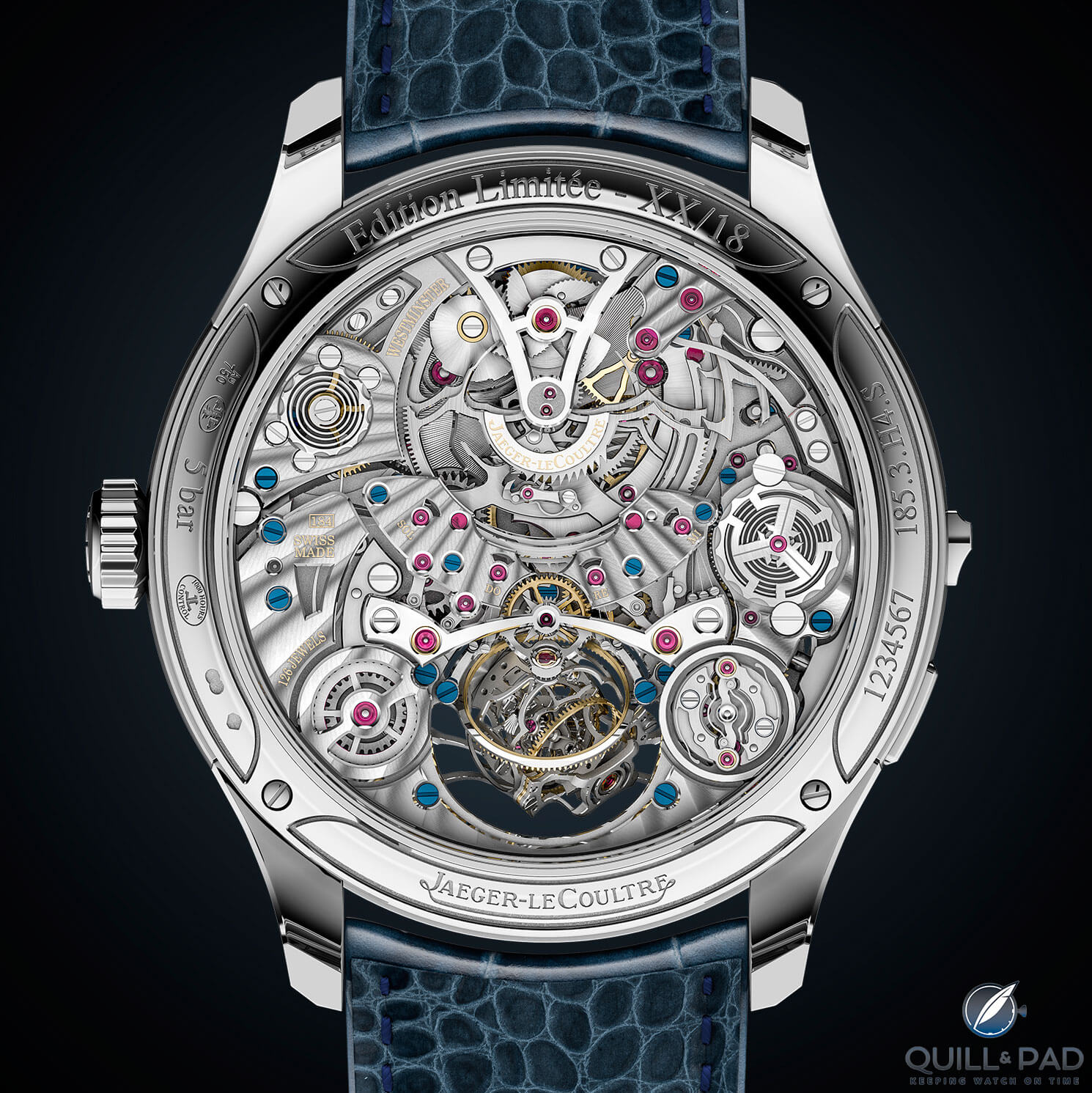
View through the display back to the incredible movement of the Jaeger-LeCoultre Master Grande Tradition Gyrotourbillon Westminster Perpétuel
Now that the minute repeater is chiming, you finally hear that iconic Cambridge Quarters (sorry, Westminster chime) melody, which is four sets of four notes played in different orders one after the other, using B, E, F sharp, and G sharp.
The sound, at least in the recordings I’ve heard, is very clear, though it is hard to tell without hearing it in person. At SIHH 2019 the prototype piece was in such high demand that we could barely get our hands on it during our appointment, but I am fairly confident that it will perform admirably based on the fact it was made by Jaeger-LeCoultre.
Cherries on the tippy top: don’t underestimate the perpetual calendar
The perpetual calendar’s layout is visually minimal, with three small windows for the year, month, and day, and the previously mentioned chapter ring for the date. But the really interesting feature of the perpetual calendar is that the date display is almost perfectly divided around the dial, but due to the size of the Gyrotourbillon mechanism there is a small gap at the bottom of the ring splitting the dates 16 and 17 apart.
One might wonder if it was actually a retrograde date, meaning it would just fly all the way back around to return to 17, but in fact every month the date jumps forward, crossing the gap to make sure the Gyrotourbillon isn’t obscured. This feature – seen in other Jaeger-LeCoultre tourbillons with date – is rare.
Jaeger-LeCoultre could have just added a sapphire crystal extension over that section (as I have seen in other watches with similar overlap issues), but opted to make a special jump that keeps the display aesthetically simple and clean.
I truly appreciate this as it would be all too easy for the movement engineer to push back against the designer and take the easier path. But instead the design integrity was maintained even when it increased complexity.
This is definitely a different development philosophy than some have (I’m looking at you, Ochs und Junior), and while it isn’t better or worse than another philosophy it shows that value is put on the aesthetic just as much as it is put on the mechanics.
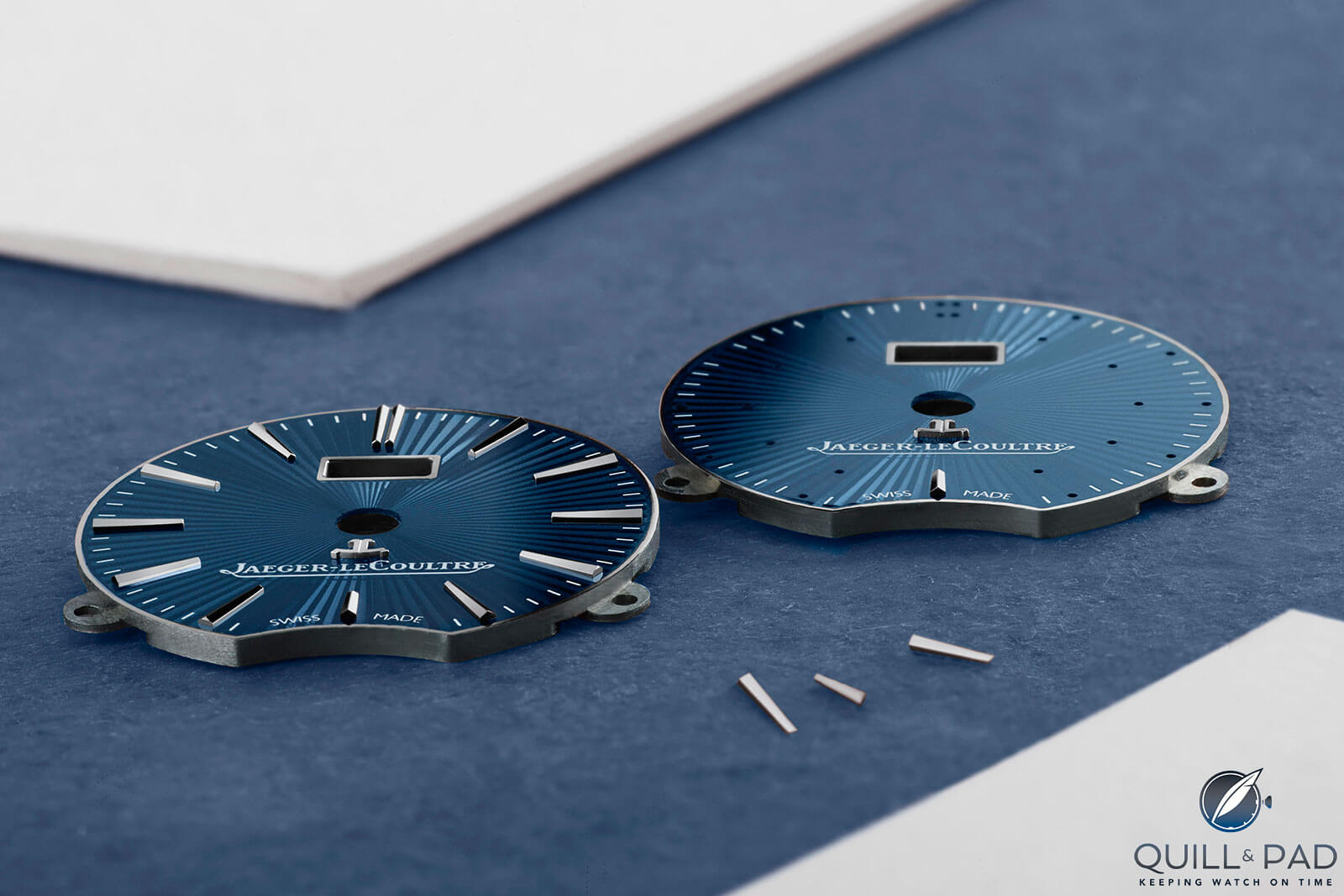
Sunray-pattern guilloche dials of the Jaeger-LeCoultre Master Grande Tradition Gyrotourbillon Westminster Perpétuel
When it comes down to it, I think that is a good way to describe Jaeger-LeCoultre. When you look across the collections and history you discover there isn’t a definite leaning either way, both mechanics and aesthetics take priority in the the brand’s timepieces.
That’s the mark of a true legend for me, something that sets Jaeger-LeCoultre apart from many of its contemporaries.
I look forward to getting time with the Master Grande Tradition Gyrotourbillon Westminster Perpétuel in the future, though it is already one of the my favorite pieces from SIHH 2019 (and Elizabeth Doerr’s), ranking fairly high on my favorite watches of all time.
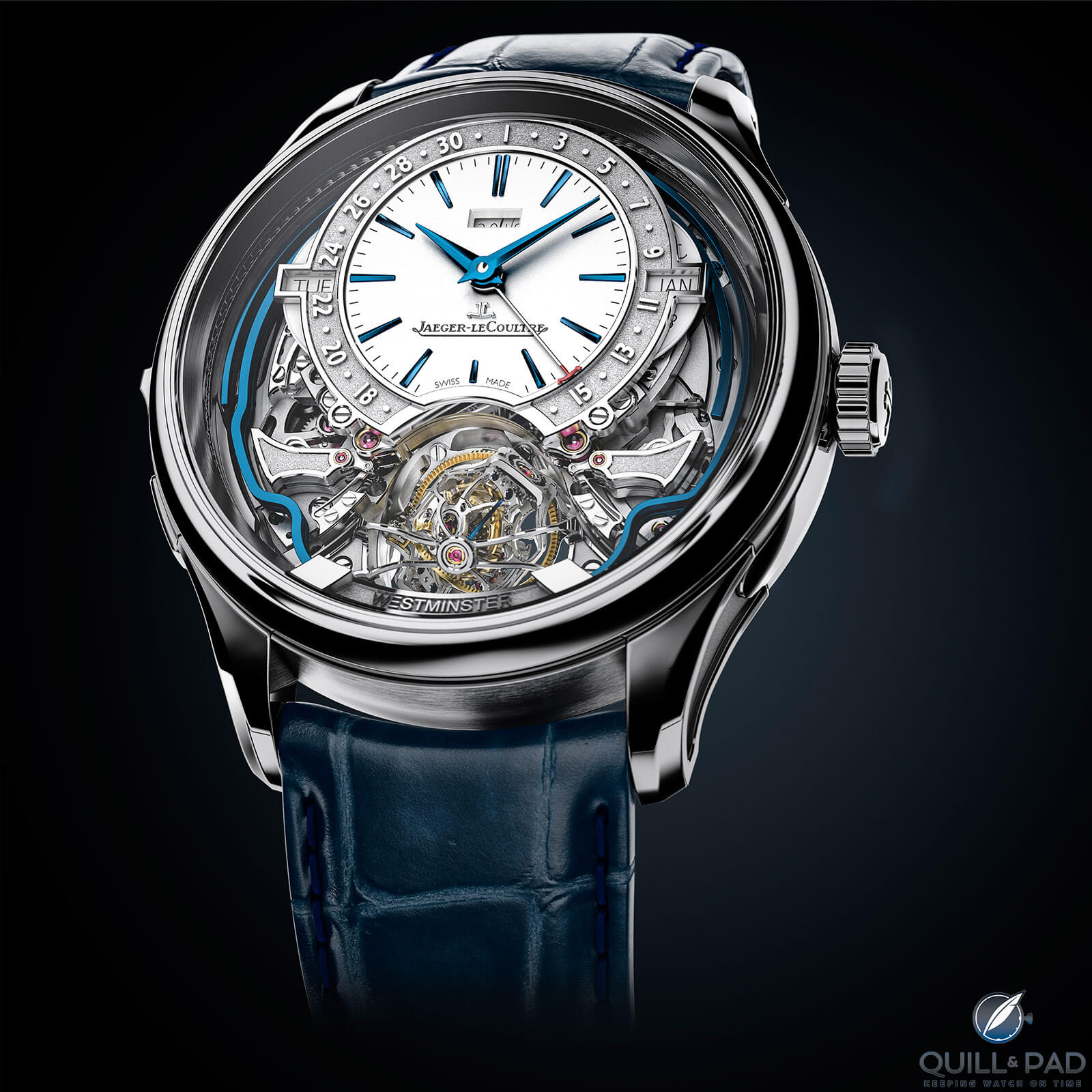
Jaeger-LeCoultre Master Grande Tradition Gyrotourbillon Westminster Perpétuel
The perfectly balanced complexity matches strongly with the straightforward aesthetic, creating a superb watch from every side.
On that note – or four – let’s break it down!
- Wowza Factor * 9.99 The only thing keeping this thing from getting a perfect ten is the perfectly restrained style that makes it a bit of a sleeper. Just a tiny bit.
- Late Night Lust Appeal * 110» 1,078.732m/s2 This watch has enough going on that it literally will keep you up for days lusting hard at the awesomazing mechanics!
- M.G.R. * 70.8 Caliber 184 ranks as one of the most impressive movements in a long time and is only kept from a perfect score because of how traditional it still is. It is amazing, don’t get me wrong, but I do value that little something that takes it into the stratosphere!
- Added-Functionitis * Severe Perpetual calendar and minute repeater with Westminster chime, of course this watch has a severe case of Added-Functionitis! Anything less than maximum prescription strength Gotta-HAVE-That cream will leave you vulnerable to the intense horological swelling.
- Ouch Outline * 11.6 The pain of a thousand micro cuts dipped in alcohol! Working my day job, I often get tiny micro cuts in my skin on my hands; it’s sort of the downside of machining. During particularly busy periods where a lot of machining is occurring those tiny cuts can add up, and only when you go to spray something down with alcohol and it gets all over your hands do you realize just how many times you have been sliced. Yet I would gladly take that pain, even on both hands, if it meant getting those hands on the Master Grande Tradition Gyrotourbillon Westminster Perpétuel!
- Mermaid Moment * You had me at Gyrotourbillon! Some may remember that one of my first horological loves was the multi-axis tourbillon, so when I see this in a new watch I immediately clear my schedule for all the wedding planning that is about to take place!
- Awesome Total * 945.9 Start with the astonishing price tag of the piece in Euros (800,000) and divide by the number of components in the movement (1,050), then add the caliber number (184) and the result is one significant awesome total!
For more information, please visit www.jaeger-lecoultre.com/us/en/chronicles/news-events/sihh-2019-new-master-grande-tradition-gyrotourbillon-westminster-perpetuel.
Quick Facts Jaeger-LeCoultre Master Grande Tradition Gyrotourbillon Westminster Perpétuel
Case: 43 x 14.08 mm, white gold
Movement: manual winding Caliber 184 with one-minute Gyrotourbillon, one-minute remontoir d’égalité, 52-hour power reserve
Functions: hours, jumping minutes, perpetual calendar with jumping date, day, month and year; minute repeater with Westminster chimes
Limitation: 18 pieces
Price: €800,000
You may also enjoy:
Beautiful Contrasts: Jaeger-LeCoultre Reverso Gyrotourbillon 2
Video: Stéphane Belmont Of Jaeger-LeCoultre Explains The Gyrotourbillon Collection





















































Leave a Reply
Want to join the discussion?Feel free to contribute!